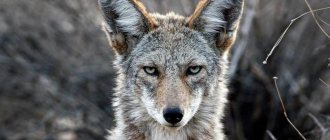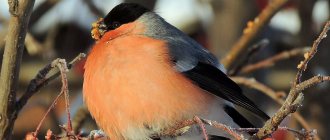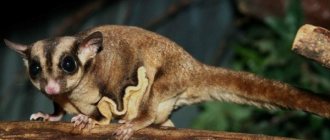What does a mole look like?
All members of the family are underground animals. They spend most of their lives underground and only occasionally appear on the surface.
The features of a mole’s adaptability to its environment are manifested in its appearance:
- The body shape of the animal is elongated, oblong;
- the paws are short, the hind legs are underdeveloped, the front ones are widened and slightly turned outward;
- the toes on the front paws are large, widely spaced and ending in strong flat claws;
- the head is small with a nose extended into a proboscis.
What sounds do moles make
? Due to constant exposure to darkness, the mole's eyes have been reduced. The eyeballs have completely lost the lens and retina. Some species of moles are able to distinguish light, but most members of the family are completely blind. The auricles are absent, hearing is poorly developed. The mole navigates and receives information using smell and touch. The most developed sense organs of a mole are the nose and the tail, which is equipped with sensitive hairs.
The entire body of the animal is covered with thick hair, and the pile easily lies in any direction, allowing the mole to move back and forth in narrow holes without turning around.
At the same time, the fitness of this species of mammals is not absolute, but relative. Thus, when it hits the ground surface, the features of the external structure of the mole lose their significance: the animals moving quickly underground become clumsy and clumsy, which makes them easy prey for predators.
What size is a mole
The length and weight of representatives of different mole species may differ:
| View | Weight | Height |
| Common mole | 70-100 gr | 12-16 cm |
| Altai mole | 150-200 gr | 17-20 cm |
| Himalayan mole | 50-60 gr | 10-13 cm |
| American shrew mole | 10 g | 6-7 cm |
Beneficial features
The European mole has useful traits. They are expressed in the fact that the animal was previously an object of the fur trade. The mammal has beautiful and durable fur. At the beginning of the last century, moles were hunted for their valuable skins. But the massive catch led to the fact that the animal began to need protection. In 1928 alone, about 20 million skins were harvested.
In the Soviet Union, mole fur clothing became popular in the 1980s. But today in Russia mammals are not hunted, which is why their population has grown. Their numbers also increase due to mild winters, the construction of greenhouses, and the care of lawns and flower beds.
Moles improve the condition of the soil. They make it loose and saturate it with oxygen, which can save the earth from the formation of swamps. Animals destroy pests because they feed on them. Moles eat chafers, mole crickets, and insect larvae.
Types of moles
Below are descriptions of animals belonging to the most common mole species.
European
Found in Europe and Asia. The animal is of medium size and has a relatively short tail (2-3 cm). The coat color is dark gray, almost black, with the belly being noticeably lighter.
European moles breed once a year, the first coat of the young is light, later the color becomes dark.
Blind
The main difference from its relatives is the complete absence of eye holes. Individuals are medium-sized, covered with dark brown fur. The range extends to the Caucasus, northern and eastern regions of Turkey, and Iran.
Starburst
An inhabitant of North America and Canada with a rather unusual appearance. The animal is distinguished by its rather large size: body length - 20 cm, tail length - 7-8 cm. Unlike other moles, the animal has a stigma formed from many movable fleshy processes, reminiscent of the tentacles of a starfish.
Another feature of the starfish is the ability to move through the snow, swim, and dive under ice. In addition to the insects and worms familiar to moles, the starfish eats fish and shellfish caught in the water.
Caucasian
The name indicates the habitat of the animal. The Caucasian mole is of medium size, dark brown fur, and its tail reaches 3 cm in length.
Long-tailed
The animal is distinguished by its small body size (8-9 cm) and a relatively long tail, which can reach a length of 4-4.5 cm. It lives in eastern Asia: China, Vietnam.
Ussuri mogera
Unlike species that have underdeveloped eyes, the Ussuri mogera has no eyes at all. It is found in the Primorsky Territory of Russia, as well as in northeast China. This is the largest mole among all known species on the planet. Its length can reach 21 cm, and its weight is 300 grams.
Description and characteristics of the animal
Name: Mole Lat.:
TalpaClass: Mammals - Mammalia Order: Insectivores - Eulipotyphla or Lipotyphla Family: Moles - Talpidae
| Habitats: | garden, forest belt, meadows and vegetable gardens |
| Nutrition: | predator, in rare cases herbivore |
| Description: | underground dweller with good hearing and sense of smell |
The mole is a representative of the class mammals. His name means “digger” and fully conveys his way of life. The animal is small in size, from 12 to 18 cm and a maximum weight of 300 grams.
The special structure of the mole family is obvious and distinctive, due to the way of life:
- the body is bar-shaped, round;
- the ears are modified, look like a roll of skin, and are covered;
- the head is compact, cone-shaped;
Common mole.
- the nose is extended, mobile, the whiskers are very sensitive;
- the eyes are formed, but small, depending on the subspecies they may be completely covered by the eyelid;
- the number of teeth varies, but they are powerful;
- the front paws seem to be turned outward with the palms, and there are fingers with powerful claws on them;
- short tail;
- the fur is thick and very velvety, wears off quickly, and the mole often sheds.
Previously, mole skins were valued industrially and were used to create clothing.
Prevalence and habitat
Moles are distributed from the north of the taiga to the dry steppes of the south. In fact, anywhere they can find food and dig in the ground. Moles cannot be found in deserts and frozen tundras. They prefer fertile soil and do not like swamps.
Although moles are excellent swimmers, they prefer edges, fields and meadows. It also settles near human habitats.
Interestingly, if necessary, moles run perfectly backwards.
Character and lifestyle
The very first and most distinctive feature is that the mole lives only underground. Of course, he will not die if he gets into the sun, but he will move back into place. The whole life of a mole consists of digging passages and labyrinths. Moreover, it has excellent organization, there are feed and running tunnels, rooms for supplies and holes for excess soil.
A mole hole is a tricky structure. A short guide can convince you of this.
Mole hole.
Moles love their home very much and return there, even if they were expelled for some reason. They can travel great distances to rivers for drinking, to search for and explore new territory or food.
The mole's character can be called grumpy and quarrelsome. He does not get along on the territory with another mole, only during mating. But the baby mole is a cute and affectionate creature. However, as they grow, they become like their parents, explore new territories and expand their housing.
Life
The animal's lifespan reaches a maximum of 6 years. They eat every 4-5 hours, after which they doze and digest.
Reserves
Moles store up to 1000 worms for the winter, but they eat them correctly, starting from the end and squeezing out the soil with their paws and teeth.
Lures
Mole passages are a cozy place for earthworms, who are happy to go to a warm place with a pleasant smell.
Habits
Moles are active around the clock and all year round. They are constantly in search of food to satisfy themselves or to gather food for the winter.
Cunning
If something happens to the mole, he stops marking the territory, then others will quickly move into his home.
Habits
The mole marks the territory with a special secretion that stands out on the abdomen. This is how he determines his place of residence.
Character
Adults are grumpy and can bite to death a relative if he accidentally enters someone else's territory.
Reproduction
Moles mate on the surface.
The mole is 21 days old.
Moreover, females enter puberty later than males. Pregnancy, depending on the type of mole, ranges from 30 days to 9 months.
In nature, their only enemies are birds of prey, which grab moles that fall to the surface. In rare cases, badgers, wild boars and martens may covet them.
Lifestyle
Moles lead a solitary lifestyle and can briefly interact with individuals of their own species only during the breeding season. The rest of the time they are characterized by quite aggressive behavior towards their relatives.
In order for his body temperature to be stable, he has to search for food almost all the time, taking short breaks to rest. This is due to the intense metabolism characteristic of all small warm-blooded animals. Digestion of food takes 3-4 hours, after which the animal is forced to go back in search of food. A long break in feeding (14-15 hours) can lead to the death of the animal.
How do they winter
There is a misconception that moles hibernate in winter. In fact, they continue to live their normal lives, showing relatively less activity than in the warm season.
Natural enemies
Moles don't have many enemies. A specific smell saves them from predators. Sometimes they can still be caught by birds of prey. This happens during spring floods. The animals' enemies are martens, wild boars, badgers, foxes, and raccoon dogs.
The only predator that is the main enemy of the mole is the weasel. She happily sneaks into their passages and catches them. The weasel does not even disdain the musky smell of a mole, which other animals do not like so much.
During the rutting period, the weasel makes a sound that moles always recognize and, sensing danger, run away. Droughts and waterlogging can kill moles. People are also the cause of the death of these animals, as they are capable of killing them either accidentally or intentionally.
Where do moles live
Various species of moles are found in North America and Eurasia. Their distribution area is limited to the temperate and subtropical climate zone.
Habitat
Suitable living conditions for moles are loose, moderately moist soil rich in nutrients. Most often, you can find signs of the presence of underground animals on the outskirts of the forest, in meadows, hills, and agricultural fields.
Moles do not settle in too wet swampy soils, rocky soil, or arid areas.
How deep in the ground do moles live?
Moles are constantly on the move and can make up to 50 m of new passages per day. In the occupied territory, animals build a whole multi-tiered system of burrows connected to each other for various purposes.
In loose soil, the mole moves at a depth of 5-10 cm, lifting the soil at the site of the tunnel construction. The depth of the passages in the soil that dries out from above reaches 50 cm. If it is necessary to build passages at great depths, the animal periodically digs vertical branches through which it throws out excess soil. Small earthen mounds are the main sign of the presence of an underground inhabitant on the site. The nest in which it rests between searches for food is located at a depth of 1.5-2 m.
From time to time, the animal makes the rounds of already dug feeding holes in search of prey that has fallen there, and also builds new passages.
How moles dig holes
Burrow construction
The mole spends most of its life underground. Only to develop a new area does it come to the surface. The animal digs two types of tunnels:
- veins;
- search engines
The first ones are also called nests; the mammal rests and hides in them during the cold season. They lie at a depth of 10−90 cm, and their diameter is only 5 cm. Closer to the surface, the mole makes search passages. He digs them so that earthworms and other underground invertebrates live nearby. The network is extensive, it can occupy significant areas - hundreds of square meters. Moles leave traces behind them: soil rollers that appear due to the swollen arches of passages.
The animal digs the ground with its front paws, and rests against the already compacted walls of the hole with its hind paws. At a depth of 10 cm, the mammal can no longer raise its head, so it throws the soil to the surface.
These heaps are called molehills; they reach 15–25 cm in height and up to 1 m in diameter. They are usually gathered in small groups. Molehills are the only sign of the presence of moles on the site that a person can detect.
How moles reproduce
Males and females reach sexual maturity by one year. Mole breeding usually occurs in early spring. The duration of gestation depends on the species: usually 1.5-2 months pass from the moment of mating to the appearance of the cubs.
There are from 5 to 10 cubs in one litter. For the first month, the female feeds the babies with milk. During this time, their teeth grow, claws appear, and their bald body becomes covered with hair. At the age of 1-1.5 months, moles begin to look for food on their own.
By 2 months, young moles become completely independent and begin to search for unoccupied territory and build a hole.
Reproduction
Moles breed once a year. The gestation period for the young varies from species to species. In the Siberian mole there is a period when the embryo stops developing for some time.
The breeding season for “Russian” moles is different:
- The European mate in March-April. The female bears offspring after 35–40 days. The cubs are blind and naked. There are 3–9 moles in a litter, weighing 2–3 g. The female gives birth once a year. Only a fifth of adult moles can produce a second litter in the summer. At 1.5 months the young animals leave the family.
- The Siberian mate mates in June, but the female gives birth the following year in April–May, since the Altai species has diapause and a total pregnancy of the mole lasts 270 days. There are 3–6 cubs in a litter. In June, young animals consider themselves adults and leave the nest. But sexual maturity in females occurs only after a year, in males after two.
- The blind mate in February–March while still under the snow. The mole bears offspring for 30 days. There are from 1 to 5 cubs in a litter. These animals grow to the size of an adult within a month, after which they leave the nest.
- The Caucasian also mates in February. The female brings moles in March. There are 1–3 cubs in a litter. After 40 days they become independent.
With such a small number of young and breeding only once a year, the number of moles in an area can increase very quickly. Since the mole gives birth deep underground, her offspring are not threatened by any predators and all the cubs remain alive.
But how long a mole representative lives depends on its species. The lifespan of the common mole is 4–5 years, the Altai mole is 5 years, the blind mole is 3–4 years, and the Caucasian mole is 5 years.
How to get rid of moles in your summer cottage once and for all
In gardens and vegetable gardens, where the soil is regularly watered and fertilized, there is always an abundance of earthworms - the main food for moles. It is not surprising that animals often settle in summer cottages and garden plots, creating inconvenience for their owners. In search of prey, moles dig tunnels, damaging the root system of plants. And despite the fact that a mole can destroy many pests (mole crickets, cockchafers, slugs, caterpillars), the harm from its activity is much greater than the benefit.
Very often, the fight against moles is carried out using inhumane methods. There are several ways that will allow you to expel animals from the site without causing them harm.
Grouse
- Planting plants that emit strong, repulsive odors. These include some flowers: marigolds, daffodils, hazel grouse. Valerian, garlic, and onion help get rid of moles. The disadvantage of this method is that the barrier will act as long as the roots of the unpleasant-smelling plants are in the ground.
- Putting rotten food in holes. To drive out moles, fresh molehills are torn up and rotten eggs, rotting fish or meat are placed in the opened passage. The top layer is covered with earth and compacted tightly. Animals do not tolerate the smell of kerosene, turpentine, or tar. You can pour a small amount of a sharp-smelling liquid into the hole and cover it with earth.
- Installation of sound repellers on the site. You can buy a ready-made device or make it yourself. The design consists of a metal pin that is driven into the ground and a device located at the top that produces sound. This could be, for example, a cut tin can or a plastic bottle with bent blades, or bells. The sounds generated by the wind are transmitted through the metal into the ground, scaring off moles.
A fence made of metal mesh, slate or other durable material will help prevent the appearance of underground animals. It is dug in to a depth of 50-60 cm along the entire perimeter of the site, with the upper edge protruding 30-40 cm above the ground.
Radical methods of controlling moles include the use of poisons, traps, and traps.
PLATYPUS
Habitat
How long a mole lives often depends on its habitat. We do not mean specific regions here, since this mammal is distributed everywhere, with the exception of the polar regions and countries with cold or too hot climates.
An important criterion for the habitat of these animals is the looseness of the soil and the abundance of invertebrates in it, which they feed on. This is why moles prefer:
- Clearings in the forest where there are no trees with their powerful rhizomes.
- Meadows in which forbs loosen the soil with their roots and fertilize it, attracting a large number of different larvae and earthworms.
- Broad-leaved and mixed young forests in which moles find attractive edges.
- Farmland where the soil is constantly loosened and cultivated.
- Hilly and mountainous terrain up to the alpine meadow zone.
If nothing disturbs the peace of moles in these places, then they can live up to 7 years.
Interesting Facts
- Moles are capable of creating food reserves: the animal immobilizes the animals caught in excess of worms by biting off their heads and takes them to specially dug chambers.
- One of the forms of adaptation of moles to living underground is intersexuality of females. It has been established that they form so-called ovotesticles: ovaries containing testicular tissue. As a result, an increased amount of male hormones enters the blood of females, which make them stronger, more aggressive and capable of not only digging holes, but also defending their territory.
- The duration of gestation of offspring by a female Siberian mole is 289 days.
- Moles secrete a musky-smelling secretion to mark their territory and alert other members of their species to their presence. As soon as the mole dies and its smell weakens, the empty hole is occupied by one of its relatives.
Lifestyle Features
Mole is a loner. It does not form families or even pairs. The meeting of a male with a relative will be the reason for a brutal fight. Or rather, massacre, because the battle will continue until the death of one of the opponents. The winner eats his victim.
The entire life of the animal passes underground . The burrows have a diameter of 4-6 cm. The passages of the residential areas go from the main cave to the watering hole. The source of life-giving moisture is any body of water: puddles, rivers, ponds, lakes, swamps, etc. The main hole - the nest is insulated with grasses or forest moss.
Nutrition
The mole is called a pest because, moving underground in vegetable gardens, it gnaws the roots of plants, which then die. But it is a mistake to think that this animal eats greens. He is far from a herbivore. What does the common mole eat? He is an insectivore. The mole eats all representatives of invertebrates that come across its path: mollusks, larvae, worms, slugs, centipedes, woodlice. It happens that he gets lizards, mice and frogs. This little guy is a terrible glutton. This is not surprising, since small mammals have to eat a lot to maintain body heat. He consumes an amount of food equal to his weight per day (60-100 grams). In winter, he eats what he managed to store.
Special constitution
The common mole is a small animal, only 10-20 centimeters in length. There is a tail located behind its body. Its length is 2 centimeters. In addition, the structure of the body also allows the mole to move underground without interference. Its skin is covered with smooth, short fur, pleasant to the touch. It does not interfere with turning and backing in dark passages, due to the fact that it grows upward and not backward. Most often, the animal has black fur, although sometimes there are exceptions in the form of ash or brown shades. But still, the fur is not immune from damage. After all, a mole has to move in a confined space.











